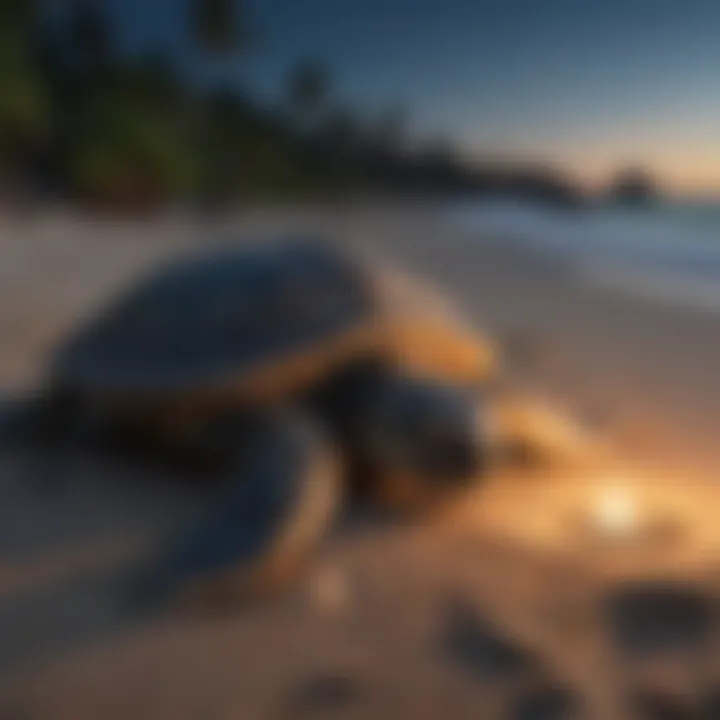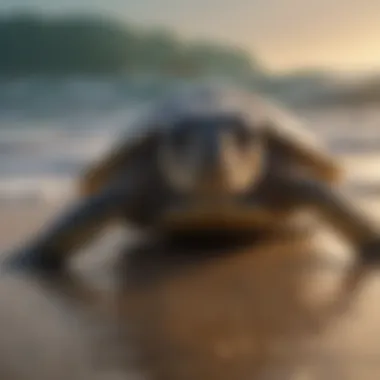The Essential Role of Sea Turtles in Sustaining Marine Ecosystems


Overview of the Topic
Sea turtles are an essential component of marine ecosystems, playing a pivotal role in maintaining biodiversity and ecological balance. These majestic creatures have existed for millions of years, evolving alongside the oceans and influencing various aspects of marine life.
Current Status and Challenges
The current status of sea turtle populations is concerning, with many species facing numerous threats and challenges. Habitat destruction, pollution, climate change, illegal poaching, and accidental capture in fishing gear are some of the primary issues endangering these ancient marine reptiles.
Sustainable Solutions
To address the plight of sea turtles, various sustainable practices and solutions have been proposed and implemented. These include the establishment of marine protected areas, implementing laws and regulations to combat poaching, promoting responsible tourism practices, and raising awareness about the importance of sea turtle conservation.
Impact and Importance
The impact of sea turtles extends far beyond their charismatic presence in the oceans. Their presence influences not only marine ecosystems but also coastal communities and future generations. Conservation efforts are crucial to safeguarding sea turtles, ensuring the health of marine environments and the well-being of countless species dependent on these gentle giants.
Introduction
Understanding sea turtles involves exploring their unique characteristics, behaviors, and their interconnectedness with the marine environment. From their intriguing breeding habits to their migratory journeys across vast distances, sea turtles exhibit a remarkable resilience and adaptability to the challenges of their oceanic existence. By recognizing the significance of these majestic creatures, we pave the way for a deeper appreciation of the complex web of life that exists beneath the ocean's surface.


In this section, we will delve into the intricate web of interactions that sea turtles participate in, shedding light on how their presence reverberates throughout the marine ecosystem. We will explore not only the biological importance of sea turtles but also their cultural and ecological significance, underscoring the need for conservation efforts to safeguard their future in our ever-changing world.
Overview of Sea Turtles
In the intricate tapestry of marine ecosystems, sea turtles stand as stalwart guardians of biodiversity and equilibrium. This section embarks on a voyage through the mesmerizing realm of sea turtles, illuminating their pivotal role in sustaining the delicate balance of oceanic life. By unraveling their significance piece by piece, we gain a profound insight into how these majestic creatures shape the marine landscape.
Classification of Sea Turtles
Venturing deeper into the realm of sea turtles, we navigate through the labyrinth of their classification. Understanding the taxonomic intricacies of these ancient beings sheds light on their evolutionary journey and ecological adaptations. From leatherbacks to loggerheads, each classification unveils a unique facet of sea turtle diversity, underscoring the multitude of forms they embody in the mosaic of marine life.
Habitat and Distribution
Traversing the vast expanses of the world's oceans, sea turtles carve their path through diverse habitats with unparalleled grace. This section delves into the intricate tapestry of their habitats, from tropical shorelines to temperate seas, unravelling the interconnectedness between these habitats and the sustenance of sea turtle populations worldwide. By exploring their distribution patterns, we gain a deeper appreciation for the global presence and importance of these enigmatic creatures.
Unique Adaptations of Sea Turtles
Embark on a journey through the evolution of sea turtles' remarkable adaptations, honed over millions of years in the crucible of nature's selective pressure. From streamlined bodies built for aquatic navigation to specialized mechanisms for respiration and thermoregulation, each adaptation is a testament to the ingenuity of these ancient mariners. Unveiling the secrets behind their survival in varying marine environments, we unravel the evolutionary marvels that define sea turtles as resilient ambassadors of the seas.
Ecological Significance


Sea turtles exhibit a profound ecological significance within marine ecosystems, playing a pivotal role in maintaining the delicate balance of life underwater. These ancient creatures are not just aesthetically striking but serve as keystone species, exerting a cascading influence on the entire ecosystem. Understanding their significance entails delving into their interactions with various components of the marine habitat, shedding light on the intricate web of connections that sustain life in the oceans. The ecological significance of sea turtles extends beyond their individual presence, encompassing their role as indicators of ecosystem health and vitality.
Sea Turtles as Keystone Species
The designation of sea turtles as keystone species underscores their critical importance in preserving marine biodiversity. As consumers of seagrass and other aquatic plants, sea turtles regulate the growth of these habitats, preventing overgrowth that could stifle other marine organisms. Moreover, sea turtles contribute to nutrient cycling by consuming prey and redistributing nutrients across different trophic levels. Their presence reverberates through the ecosystem, influencing the abundance and distribution of various species. By serving as keystones, sea turtles play a central role in shaping the structure and functioning of marine environments.
Role in Maintaining Coral Reefs
Sea turtles play a significant role in the health and resilience of coral reefs, acting as key herbivores that control algal growth and prevent reef degradation. Through their foraging activities, sea turtles help to maintain the delicate balance between corals and algae, preserving the structural integrity of reef ecosystems. The grazing behavior of sea turtles promotes coral growth by reducing competition from algae, allowing corals to thrive and support a diverse array of marine life. Their presence within coral reef ecosystems is thus essential for the long-term sustainability and conservation of these crucial marine habitats.
Impact on Seagrass Beds
Seagrass beds constitute vital marine habitats that support diverse ecosystems and provide numerous ecological benefits. Sea turtles, as primary consumers of seagrass, play a crucial role in shaping the structure and productivity of seagrass communities. By grazing on seagrass leaves, sea turtles maintain the health and growth of these habitats, preventing them from becoming overgrown and promoting species diversity. The feeding behavior of sea turtles influences the nutrient dynamics and productivity of seagrass beds, highlighting their indirect but significant impact on coastal ecosystems. Protecting sea turtles is therefore essential for safeguarding the integrity and resilience of seagrass habitats.
Conservation Challenges
The realm of conservation challenges related to sea turtles is vast and intricate, demanding attention to secure the future of these majestic creatures and the marine ecosystems they inhabit. Understanding and addressing these challenges are paramount in ensuring the sustainability of sea turtle populations. Conservation efforts encompass a wide array of tasks, from mitigating human-induced threats to implementing protective measures that foster the well-being of sea turtles.
Threats to Sea Turtles


Sea turtles face a myriad of threats that jeopardize their existence, ranging from habitat degradation and loss to climate change impacts. Pollution, marine debris, and plastic ingestion pose immediate dangers to these ancient reptiles. Moreover, incidental capture in fishing gear, known as bycatch, leads to fatalities among sea turtle populations. The destruction of nesting sites due to coastal development further exacerbates the plight of these vulnerable creatures.
Human Activities and Sea Turtle Conservation
Human activities play a pivotal role in shaping the conservation landscape for sea turtles. By understanding the intersection between human actions and sea turtle survival, conservationists can devise effective strategies to mitigate negative impacts. Encouraging responsible tourism practices, reducing light pollution along nesting beaches, and regulating fisheries to minimize bycatch are crucial aspects of human engagement in sea turtle conservation.
Efforts to Protect Sea Turtles
A multitude of initiatives are underway globally to safeguard sea turtles and their habitats. Conservation organizations collaborate with local communities and governments to establish protected areas, enforce regulations, and conduct educational programs on the importance of sea turtle conservation. Employing satellite tracking technology, enhancing on-ground monitoring efforts, and advocating for sustainable fishing practices represent integral parts of the comprehensive approach to safeguarding these iconic marine species.
Research and Monitoring
Tracking Studies
Tracking studies play a vital role in understanding the migratory routes and behavior of sea turtles. By attaching satellite tags or transmitters to individual turtles, researchers can track their movements in real-time, providing valuable data on their habitat use, migration patterns, and interaction with human activities. Tracking studies help scientists identify critical foraging areas, breeding grounds, and migration corridors, enabling conservationists to protect these key habitats. By analyzing tracking data, researchers can assess the impact of environmental changes, climate variability, and anthropogenic threats on sea turtles. This information helps in designing targeted conservation measures and mitigating potential risks to sea turtle populations.
Population Surveys
Population surveys are essential for estimating the abundance, distribution, and health status of sea turtle populations. By conducting comprehensive surveys, researchers can assess population trends, evaluate demographic parameters, and monitor changes in population size over time. Population surveys involve methods such as aerial surveys, beach counts, and nesting beach monitoring to collect data on nesting females, hatchlings, and juvenile turtles. These surveys provide critical information for population modeling, trend analysis, and conservation planning. By understanding population dynamics, conservationists can implement adaptive management strategies and conservation actions to safeguard vulnerable sea turtle populations.
Technological Advancements in Sea Turtle Research
Technological advancements have revolutionized sea turtle research, providing innovative tools and techniques for studying these marine reptiles. From satellite telemetry and unmanned aerial vehicles to genetic analysis and bio-logging devices, technology has enhanced the scope and accuracy of sea turtle research. Technological advancements enable researchers to track turtles over long distances, monitor their physiological parameters, and investigate their genetic diversity. By utilizing cutting-edge technologies, scientists can unravel the complex ecology of sea turtles, uncovering hidden patterns and connections that shape their survival. Technological advancements in sea turtle research offer exciting opportunities for gaining new insights into their behavior, health status, and adaptation to changing environments, driving conservation efforts towards a more informed and sustainable future.
Conclusion
Sea turtles, despite their serene demeanor, are pivotal creatures in the intricate web of marine ecosystems. The significance of these ancient beings goes beyond their charismatic appeal; they serve as keystone species, holding together the delicate balance of biodiversity underwater. As the guardians of the sea, sea turtles play a crucial role in shaping the health of coral reefs and seagrass beds, acting as indicators of the overall well-being of the oceans. Conservation efforts aimed at protecting sea turtles are not just for the sake of these majestic creatures but for the preservation of entire ecosystems that rely on their presence. By safeguarding sea turtles, we are ensuring the resilience and stability of marine habitats for generations to come



